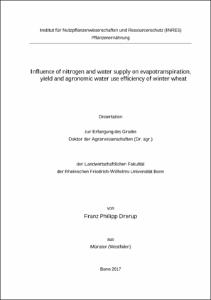Drerup, Franz Philipp: Influence of nitrogen and water supply on evapotranspiration, yield and agronomic water use efficiency of winter wheat. - Bonn, 2017. - Dissertation, Rheinische Friedrich-Wilhelms-Universität Bonn.
Online-Ausgabe in bonndoc: https://nbn-resolving.org/urn:nbn:de:hbz:5n-46939
Online-Ausgabe in bonndoc: https://nbn-resolving.org/urn:nbn:de:hbz:5n-46939
@phdthesis{handle:20.500.11811/7013,
urn: https://nbn-resolving.org/urn:nbn:de:hbz:5n-46939,
author = {{Franz Philipp Drerup}},
title = {Influence of nitrogen and water supply on evapotranspiration, yield and agronomic water use efficiency of winter wheat},
school = {Rheinische Friedrich-Wilhelms-Universität Bonn},
year = 2017,
month = may,
note = {The predicted climate change for North West Europe, which will be characterized by higher temperatures and lower rainfall during the summer months, will challenge future food production. Against this background, the question is how nitrogen supply influences the evapotranspiration (ETa) and the agronomic water-use-efficiency (WUEy). Literature regarding drought stress reactions of winter wheat (Triticum aestivum, L.) grown in the temperate humid climate of North West Europe is scarce. Because of this a field trial with variable nitrogen and water supply was conducted during 2013-2015 at the Research Center for Crop Nutrition Hanninghof in Dülmen. To induce different water regimes (fully watered control, early drought, early and late drought) rain-out-shelter and drip irrigation systems were installed. Different N-supply treatments (unfertilized control, 120 and 230 kg N ha-1) were induced using calcium ammonium nitrate (27% N). A realistic calculation of ETa is the key for the quantification of the impact of nitrogen on WUEy. Therefore two different calculation approaches for estimating ETa according to the FAO 56 method were compared. ETa was calculated based on handspectrometer measurements converted to crop coefficients (Kc-values) (NDVI-approach) and on the other hand based on published Kc-values and Kc duration periods (tabulated-approach) for plots that were not water and nitrogen limited. In general, it could be concluded that the method for estimating ETa according to FAO 56 showed realistic results. Furthermore, the data showed that the NDVI-approach, in contrast to the tabulated-approach, allowed a realistic calculation of ETa. Tabulated values could only be used retrospectively for estimating ETa, whereas the NDVI-approach can take growth influencing parameters (weather, pests, lack of nutrients) into account and can therefore be used to quantify ETa during the vegetation season. For this reason we used the NDVI-approach to calculate the ETa for plots that were limited in their water and nitrogen supply. If water was not limited a higher nitrogen rate increased grain yields of wheat more than ETa. The positive effect of nitrogen fertilization on WUEy was mainly caused by a reduction of soil evaporation. This effect was more pronounced under wet than under drought conditions. The results of this study also showed that the NDVI-approach can be used not only to quantify ETa but also to measure yield reductions caused by drought stress (Ky-value) during the vegetation period. Drought stress during booting also caused grain yield reductions. This study showed that a high N-supply compared to moderate N-supply under early drought and continuous drought conditions increased both grain yields and ETa in a more water use efficient way. We refer this positive N-effect to the fully water saturated soils at the start of the vegetation period in spring.},
url = {https://hdl.handle.net/20.500.11811/7013}
}
urn: https://nbn-resolving.org/urn:nbn:de:hbz:5n-46939,
author = {{Franz Philipp Drerup}},
title = {Influence of nitrogen and water supply on evapotranspiration, yield and agronomic water use efficiency of winter wheat},
school = {Rheinische Friedrich-Wilhelms-Universität Bonn},
year = 2017,
month = may,
note = {The predicted climate change for North West Europe, which will be characterized by higher temperatures and lower rainfall during the summer months, will challenge future food production. Against this background, the question is how nitrogen supply influences the evapotranspiration (ETa) and the agronomic water-use-efficiency (WUEy). Literature regarding drought stress reactions of winter wheat (Triticum aestivum, L.) grown in the temperate humid climate of North West Europe is scarce. Because of this a field trial with variable nitrogen and water supply was conducted during 2013-2015 at the Research Center for Crop Nutrition Hanninghof in Dülmen. To induce different water regimes (fully watered control, early drought, early and late drought) rain-out-shelter and drip irrigation systems were installed. Different N-supply treatments (unfertilized control, 120 and 230 kg N ha-1) were induced using calcium ammonium nitrate (27% N). A realistic calculation of ETa is the key for the quantification of the impact of nitrogen on WUEy. Therefore two different calculation approaches for estimating ETa according to the FAO 56 method were compared. ETa was calculated based on handspectrometer measurements converted to crop coefficients (Kc-values) (NDVI-approach) and on the other hand based on published Kc-values and Kc duration periods (tabulated-approach) for plots that were not water and nitrogen limited. In general, it could be concluded that the method for estimating ETa according to FAO 56 showed realistic results. Furthermore, the data showed that the NDVI-approach, in contrast to the tabulated-approach, allowed a realistic calculation of ETa. Tabulated values could only be used retrospectively for estimating ETa, whereas the NDVI-approach can take growth influencing parameters (weather, pests, lack of nutrients) into account and can therefore be used to quantify ETa during the vegetation season. For this reason we used the NDVI-approach to calculate the ETa for plots that were limited in their water and nitrogen supply. If water was not limited a higher nitrogen rate increased grain yields of wheat more than ETa. The positive effect of nitrogen fertilization on WUEy was mainly caused by a reduction of soil evaporation. This effect was more pronounced under wet than under drought conditions. The results of this study also showed that the NDVI-approach can be used not only to quantify ETa but also to measure yield reductions caused by drought stress (Ky-value) during the vegetation period. Drought stress during booting also caused grain yield reductions. This study showed that a high N-supply compared to moderate N-supply under early drought and continuous drought conditions increased both grain yields and ETa in a more water use efficient way. We refer this positive N-effect to the fully water saturated soils at the start of the vegetation period in spring.},
url = {https://hdl.handle.net/20.500.11811/7013}
}






